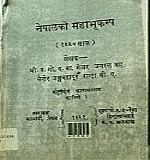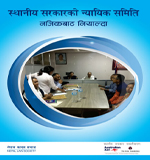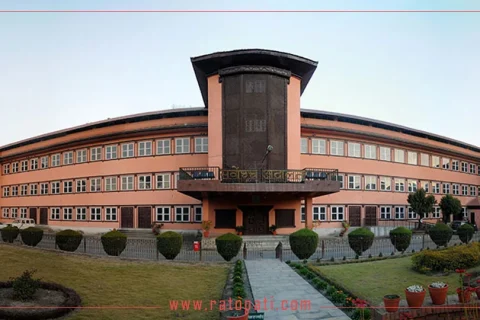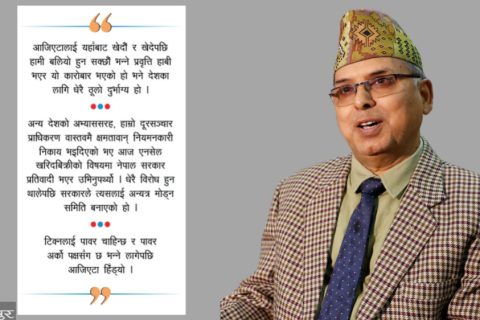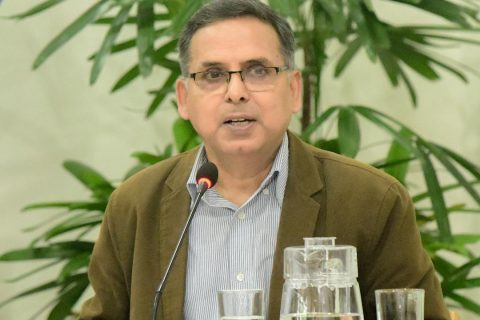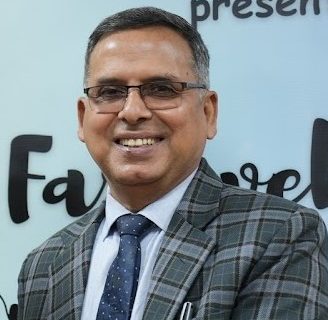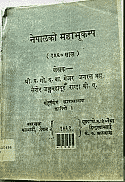
Major General Brahma Shamsher, Nepalko Maha Bhukampa 1990 [Kathmandu, 1935]
The book of Major General Brahma Shamsher Nepalko Maha Bhukampa 1990 [Kathmandu, 1935] presents graphic accounts of the great earthquake of 1934. This earthquake was not only powerful, but also the most destructive of all the earthquakes in the living memory of Nepal.
As Nepal is in the seismic zone, earthquakes are not uncommon in this land. The earthquake of June 7, 1255, which is regarded as the first recorded earthquake in the history of Nepal, has is believed to have claimed nearly one third of the total population of Kathmandu. King Abahya Malla was one of them. Similarly, another mighty earthquake was recorded in 1260 during the reign of King Jayadev. It was also as destructive as the 1255 earthquake. There was a huge loss of life and an epidemic and famine after the earthquake. Many buildings and temples collapsed this time as well. The history of Nepal describes the destruction of the temple of Rato Matchendranath by the earthquake of 1408 when Shyam Singh was the King. Another earthquake of 1681 at the reign of King Sri Niwas Malla is also said to have been as devastating. In the months of June and July of 1767, an additional earthquake of significant intensity was recorded. There must have been many other devastating earthquakes in every century. But there are no written records. It is only the 1934 earthquake that has been addressed by a book, for which Major General Brahma Shamsher must be thanked.
According to Brahma Shamsher, the first shock of 1934 earthquake broke out on 16 January. It had been raining the days and nights before. The early morning brought with it heavy fogs, even though the sun shone at 60 degrees, and people were sitting in their gardens, rooftops, and streets, trying to feel its warmth. The celebration from yesterday’s makar samkranti, the Hindu festival marking the transition of the Sun into makar (capricorn)rashi on its celestial path, still clung in the air. Women had been fasting and performing various observances due to the aunsi the following Monday, while men worked in the fields. Government workers were busy in their offices, while the marketplace swarmed with villagers bringing in fresh produce to sell to city people. It was definitely a beautiful day.
Exactly at 2:24:22 pm, there was a strong rumbling in the ground as it began to shake; the infamous earthquake of 16 January 1934 was taking place. Like the waves of the water, the earth moved from the east to the west. In the second stage, the ground seemed to be twisting as houses and electricity poles collapsed. The tops of trees seemed to bend to meet the ground. The waters from ponds and buckets spilled, as if giant waves were at play. As if caused by the winds, the doors and windows of houses began to open and shut, if they were not collapsing with the sounds of firing tanks. Dust rose to obstruct what little sunlight there was.
People began running towards open spaces. Some stood still as they couldn’t find something to hold onto, while others crawled on all fours to get away. Some ran towards corners, and some ran to their gardens or fields. Mothers ran inside to retrieve their forgotten children, only to be killed by the crumbling buildings. Like trees cut down with axes, Dharahara and Ghantaghar both parted down the middle, breaking into large chunks. Nobody saw it coming. Despite the darkness from the dust, panic caused people, crying out to God to save them, to run for their lives. The mélange of these sounds created a panicked environment.
However, even the ones that ran were not guaranteed safety, as narrow gullies and smaller roads were very risky. Thousands died at the mercy of the collapsing buildings, thousands were wounded, and the soldiers training in Tundikhel laid face-down as they were unable to stand up. Water poured out from the nine to fifty meter cracks in the fields and roads, as rivers, including the Bagmati and Bishnumati, flooded, some reaching as high as seven to ten feet. In Balaju and Sankhamul, parts of roads caved in by a couple feet.
The earthquake was horrible. As it subsided, family members began looking for one another, screaming each other’s names in the streets. People started running towards their houses, digging through the rubbles to find their buried relatives, some dead and others calling for help. It’s hard to imagine the fear and trauma that went through people’s heads. Survivors gathered in Tundikhel and open spaces, crying out to each other. The king was in the Nagarjun hills when the earthquake took place. Two daughters of the king and the prime minister’s granddaughter were found to be dead.
Brahma Shamsher, who wrote this book in Nepali, lauds the role of the national army in the post-earthquake situation. They were quick to gather to receive instructions from the authority and disperse into the city for the purpose of rescue. It is hard to fathom what went through their hearts as they saved others, no matter what happened to their own families and houses. These soldiers were loyal to their country and followed instructions determinedly. Indeed, they rescued many people from under the rubbles.
People who were injured or homeless went to hospital grounds for medical attention and shelter. Mothers bearing dead children arrived, hoping against hope that the doctors could somehow revive their children. Those on duty attended to those injured, even though common people were attempting to help each other.
In many places, fires broke out due to the crumbling timbers used in the buildings; however, the fires were controlled because of weak winds. Traditional edible oil plants at Khokana also caught on fire but were maintained as well. In Pharping, the only power house of the country was damaged and shut down because of the earthquake.
For somebody awaking from unconsciousness, the world seemed to be ending in total destruction. Every person, birds, and animals seemed to be screaming in pain. Even an animal like a tiny rat could not escape the destruction and died under the rubbles. The author asks the readers to picture the unfortunate mother who tried helplessly to clear the debris to uncover her son whose dying voice carries through “aamaa!.” He also asks to imagine the orphan who lost his 11-member family as his home collapsed, or think of the 15-year-old young Bahuni widow who beat her chest with her fists, mourning the death of her husband. In the rubbles, somebody’s head was split wide open, or somebody’s hand was broken. People were still missing, while others were being dug out.
Corpses laid around the house, awaiting cremation. There were no shops where one could buy cloth to wrap the dead or wood for cremation. People make-did with the pieces of broken wood and timbers from their own homes. The father was dead, but the son did not have the razor to shave his own head or a new set of mourning clothes to wear for performing after-death rituals. The priest did not have the holy book with the instruction for cremation. The cremation location was also crowded with corpses, and people were struggling for their turns. Those who could not afford to cremate amicably resorted to disposing their dead in the Bagmati river. One cannot begin to describe the devastation of the animals.
The whole city was destroyed. Many of the people were assembled at Tundikhelbecause of lack of shelter. They all feared the winter rain which was very likely. No matter how rich or poor, they gathered together in fields or open spaces for the night. Thousands of people had no shelter at all. Because the Nagarjun palace had also broken down, the king was forced to stay in a tent. Only a few could afford anything to eat. Water taps began to clog because of cold. The whole night, people experienced countless aftershocks of the earthquake. That night passed painfully.
The day after, many people emerged alive from the debris because of the effort of the soldiers. Forty to fifty people were buried in one place. Officers went to different villages to assess the situation. An earthquake volunteer named Premraj, has been quoted by the author as saying: “Among the places I visited, the scenes of the Sanagaun and Lubhutown were most heartbreaking. From the 1500 to 2000 roofs that existed previously, in these places, not even four or five remained. When before, the settlement was full of roofs withjhingati tiles, now it appeared to be a naked, battered hill.”
The town of Birgunj was also destroyed. The sole telephone line between Kathmandu and Birjung was disconnected, which led to horse-riders being sent to disseminate rescue and relief information. The light railway of the Nepal Government was also a victim of the destruction.
Aftershocks were quite common. On the third day, there was another big earthquake. The trauma was intensified. For three or four days, chaos prevailed. However, gradually, it lessened as people began to adapt to the earthquake.
It has been said the earthquake of magnitude 8.4 Richter scale in 1934 claimed 8519 people’s lives, destroyed 80893 buildings, and severely damaged 126355 more houses. At that time, the government spent Rs 2,06,500 through the earthquake relief fund in Kathmandu valley alone. The earthquake relief fund established by the king offered loans to those affected throughout the country.
It must be noted that Prime Minister Juddha Shamsher JBR, a hereditary executive, left no stone unturned to announce the relief efforts after the earthquake of 1934 and cater to the people in need for years later. He was able to do everything that was possible at that moment. In fact, his Kharibot speech to the nation, in which he explained to the common people in 1938 how the government tackled the devastation, provided relief to the earthquake victims and affected people, started the process of reconstruction and re-aroused the passion of a nation that almost collapsed, is still a living testament of Nepal’s capacity for disaster management. The issue for the future generation is whether it has learnt anything from that experience.
Major General Brahma Shamsher must be appreciated for this important book. Many years later, the author also fought with distinction in the British 14th Army and was presented with the Assam-Burma Medal (1945), British 39/45 & Burma stars, and Defence and War medals (1945).

